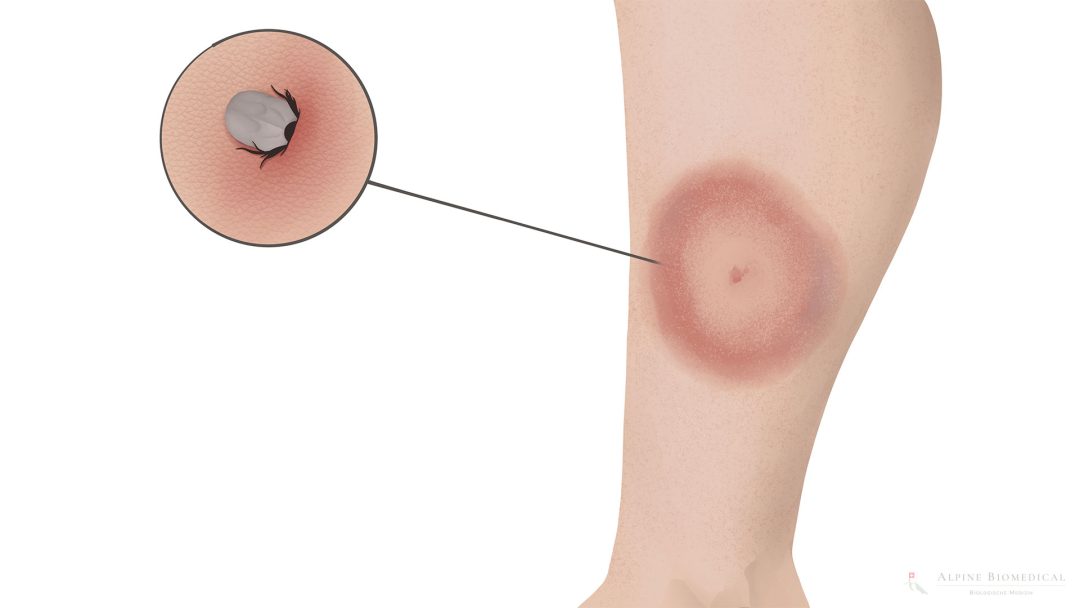Lyme Disease

Lyme disease, also known as Lyme borreliosis, is an infectious disease transmitted by ticks. It is caused by bacteria of the Borrelia genus, and the infection can affect various organs, leading to diverse symptoms. In Europe, infection can occur anywhere, with forests and tall grass posing a particular risk.
Transmission of Lyme Disease
Lyme disease is primarily transmitted by ticks. An infected tick can transfer Borrelia pathogens to humans during a tick bite. In rare cases, infection can also occur through mosquitoes or horseflies. A tick bite involves the removal of blood with a piercing mouthpart. Not all ticks are infected, and not every tick bite necessarily results in pathogen transmission. However, caution should be exercised, as the likelihood of Lyme disease infection increases after a tick bite.
Erythema Migrans (EM) or Bull's Eye Rash
Erythema migrans, also known as the bull’s eye rash, is a critical symptom in the early stage of Lyme disease, occurring in approximately 70% of cases. It is an immunological reaction of the skin around the tick bite site, accompanied by a circular redness. Such a rash may develop days or weeks after the tick bite and serves as a clear indication of a Lyme disease infection. The affected person should promptly consult an experienced physician.
Early Stage of Lyme Disease
The first symptoms of Lyme disease can occur days to months after infection. Therefore, the term “early stage” in Lyme disease describes a period of up to 6 months. During this time, the following symptoms may appear:
- Inflammation and pain in joints and muscles
- Headaches
- Neuralgia (pain along the nerves)
- Symptoms of cranial nerves, especially facial paralysis
- Sensory disturbances
- Heart rhythm disturbances
- Vision problems, for example double vision
The early stage transitions smoothly into the chronic stage, which predominates when symptoms persist six months after infection.
Chronic Lyme Disease and Late Consequences
The early stage transitions smoothly into the chronic stage, which prevails if symptoms persist six months after infection. The chronic stage of Lyme borreliosis exhibits diverse disease manifestations. The symptoms are occasionally referred to as late-stage effects of Lyme disease, even though it is the same latent persisting Lyme borreliosis condition.
Symptoms of chronic Lyme disease include:
- tiredness, exhaustion, and fatigue
- Inflammation and pain in joints and muscles
- Neurological disorders, e.g., polyneuropathies
- Gastrointestinal issues
- Skin problems (for example acrodermatitis chronica atrophicans Herxheimer)
- Vision disturbances
- Cardiovascular problems
- Hormonal disorders
- Immunological imbalances
- Autonomic dysregulations
Chronic Lyme disease leads to diverse systemic symptoms, resulting in various differential diagnoses.
Treatment of Lyme Disease
The conventional treatment of Lyme disease involves appropriate antibiotics, selected based on individual laboratory examinations. The choice of medication and treatment duration depends on the disease phase and prevailing symptoms.
Alternatively or supportively, complementary medical therapies can be considered. Methods such as hyperthermia, INUSpheresis, or infusion therapy can provide high-quality and effective support in Lyme disease treatment. Plant-based antibiotics and immune-stimulating medicinal mushrooms also play a role. A well-adjusted correction of micronutrient deficiencies and an intestinal cleanse should be considered in Lyme disease treatment.
Dr. med. Karsten Ostermann M.A.
Lyme disease can cause quite a lot of damage to our bodies. Those affected can be helped effectively with the help of an individually tailored treatment plan.

Frequently asked Questions about Lyme Disease
The condition of Lyme disease involves many complex interconnections, raising various questions for affected patients. In this section, we address commonly asked questions.
Ideally, you should promptly seek medical attention after a tick bite. If visiting a doctor is not possible, pay close attention to emerging symptoms. If you notice a bull’s-eye rash, it is crucial to see a doctor urgently.
In case of a tick bite, you should seek immediate medical attention from a doctor specialized in Lyme disease.
When someone speaks of the late consequences of Lyme disease, they usually refer to the symptoms of Lyme disease in the chronic stage (6 months after infection). Symptoms can affect all organ systems and vary widely, with individuals experiencing fatigue, neurological issues, gastrointestinal problems, inflammatory pain in joints and muscles, etc.
Further information
The information listed contains relevant topics and serves to improve understanding.